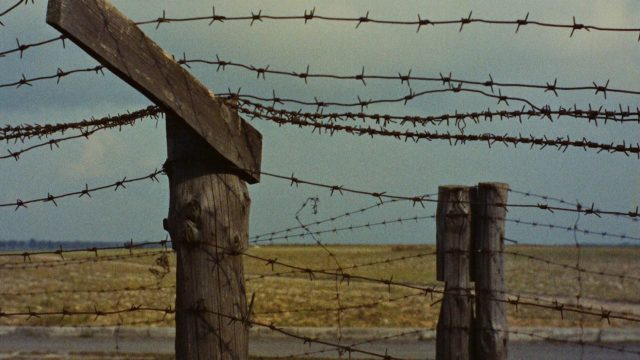Even a peaceful landscape, even a meadow in harvest with flights of crows and grass fires, even a road for cars and peasants and couples, even a resort village with marketplace and steeple, can lead to a concentration camp.
-Opening narration
“There are no words” is the stock response to confrontations with things horrible and true. Unspeakable, these events are called. Unspeakable in the sense that no word can articulate what this means, but unspeakable also denotes taboos and things left unsaid intentionally. But carrying the past requires words. The unspeakable must be spoken.
Alain Resnais resisted the assignment to make a film about the unspeakable until he was allowed a collaborator to provide the words. Tasked with making a film based on eyewitness accounts of the Holocaust ten years after the liberation of the camps, Renais turned to novelist, poet and Holocaust survivor Jean Cayrol to provide the script for what would become Night and Fog (Nuit et brouillard). The resulting script has a dry urgency and actor Michel Bouquet reads it with a droning detachment familiar to documentary. But here the detachment sounds like a defensive dissociation, an attempt to avoid going mad in the presence of the images.
And the images are maddening, clutch your head and cover your eyes. Renais intercuts vibrant color footage of the abandoned camps in the present with black-and-white archival footage of the atrocities and aftermath of the systematic murder of millions. Even living today when Holocaust history lessons have been available for a lifetime, with their pictures of skeletal prisoners and chimneys belching ashes, the frankness of the images in Night and Fog shock.
The 1940s cameras also caught a recognizably French uniform on one of the guards by prisoners awaiting transport, an embarrassment that French censors forced Resnais to literally paint over (newer versions correct this back to the untouched frames). It’s exactly this dodging of responsibility that Resnais feared in creating the film, particularly as he saw the potential for his own country to repeat the past during the ongoing war in Algeria.
Resnais knew the images would force the viewer put as much distance between themselves and the screen as possible. The monochrome newsreels could read as memories of distant events even in 1956. The color footage of the camps’ present state could be mistaken for a happy ending to the story: Look how these sites of monstrosities now rust. Look how the barracks have crumbled, how weeds have overtaken the roads.
Without Cayrol’s script the buildings are just brick and wood. A line of disused train tracks are metal lines losing a battle with nature. The narration reminds that the train ride is when “death makes its first choice.” As Resnais dollies along the wooden bunks in the barracks, Cayrol recounts the fear and desperation lived out day to day in the camps with the kind of details only a Survivors could tell. “One would need the straw mattress, both pantry and safe, the blanked one fought for…” he writes. When Resnais films an endless row of latrine holes Cayrol conjures “skeletons with bloated stomachs” visiting “seven or eight times a night. The soup saw to that.”
The narration points out the limitations of the image – “we can only show you the outer shell, the color.” Yet the script at times questions its own contribution, also insisting it’s “useless to describe what went on in these cells,” and “words are insufficient.” The footage fills in where words fail.
The organization, the casual postures of the guards who would later profess ignorance and horror. The bizarre, like a prisoner assisting the Nazi closing the door of his cattle car, the inexplicable among the unfathomable.
Charred remains with facial features. Heads in a basket. Naked, shivering bodies moments from becoming corpses. Bodies stacked like firewood – stacked among firewood. Bodies shoved into pits with a bulldozer. Sometimes the narration simply names what we see. Much plays without comment. There are no words.
Cinematographer and poet, sight and sound work in concert to shock the system when memory fades and guide the mind when the nerves recoil. Neither words nor pictures are sufficient to recreate the Holocaust, the map needs to shrink to fit the page. The best we can do is to watch and listen, compare the notes we’ve been given to the world around us, and hope for the courage not to fail when we recognize the approach of the unspeakable.

